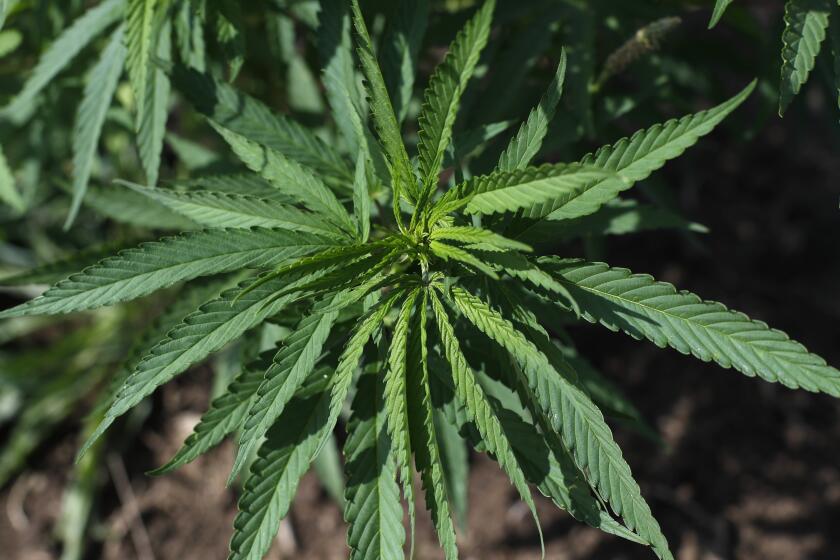U.S. Renews Herbicide Use in War Against Marijuana
WASHINGTON — The Drug Enforcement Administration, limited for two years to hoes and machetes in its war against marijuana growers, renewed its use of chemical herbicides as weapons Friday, raising the possibility that paraquat again will be sprayed over federal lands.
DEA agents began Friday to use the herbicide glyphosate in an operation designed to kill 10,000 marijuana plants grown illegally on federal lands in the Midwest, Administrator John C. Lawn said in announcing the new strategy.
The DEA had been prohibited from using herbicides under terms of a 1983 federal court order after environmental groups filed suit to stop the Administration from spraying paraquat on marijuana patches in federal forests in Georgia and Kentucky.
At that time, the DEA agreed to conduct an environmental study on the impact of herbicides, which formed the basis of Friday’s decision to resurrect the chemical weapons.
That study, completed in July, concluded that paraquat and two other herbicides--glyphosate and 2,4-D--can be used safely and effectively to kill marijuana plants. The DEA considers paraquat the most effective of the three.
Lawn said that the “operational flexibility” of the new approach--which lets DEA agents choose between poisoning marijuana plants and chopping them down--will help the agency rid the nation of “this noxious element.”
“I think we should have available to us all the means available to eradicate marijuana in our society,” Lawn said.
Before the DEA can again use paraquat, the manufacturer, Chevron Chemical Co. of San Francisco, must request a label change--also ordered by the court--specifying that the product can be used against cannabis (the botanical name for marijuana), and the Environmental Protection Agency must accept that change.
The EPA long has contended that paraquat can be used legally for marijuana control because the plant is classified as a “broad-leaf weed.” A spokesman said Friday that a request for a label change would likely be quickly approved.
Change Not Requested
But despite pressure from the DEA, Chevron Chemical has not yet requested a label change. A spokesman for the firm, G. Michael Marcy, said that if the DEA could demonstrate that the use of paraquat would be environmentally safe, the company would be “open to sitting down and discussing the request with them further.”
California officials long have contended that because the paraquat label does not specifically list cannabis, the product cannot be used for marijuana eradication.
Robert Peterson, an official in the state’s division of pest management, said that the state would have to “wait and see” whether paraquat wins EPA approval for use against marijuana before taking a position on its use by federal officials. Because both glyphosate and 2,4-D are licensed by the state for use in forest areas, he said, the state would “not have nearly the same concerns” about their use.
The escalated strategy of marijuana eradication applies only for DEA operations against marijuana crops on federal lands in the continental United States, where an estimated 17% of the nation’s marijuana crop is illegally grown.
Draft Urges Paraquat Use
A draft copy of a second environmental impact study lists as “preferred” a recommendation that would allow DEA agents to use paraquat and other herbicides throughout the rest of the country. They are currently prohibited from doing so, although state and local authorities may use herbicides.
The National Coalition Against the Misuse of Pesticides and an organization for the legalization of marijuana immediately said that they would sue the DEA, charging that the agency inadequately examined the potential impact of the weed killers on humans and wildlife.
“We contend that the DEA failed to consider a number of reports, including one last month by the EPA that concluded glyphosate is a carcinogen,” said Kevin Zeese, national director of the National Organization for the Reform of Marijuana Laws.
Al Heir, a spokesman for the EPA, said that glyphosate, one of the world’s most widely used herbicides, is “a very weak carcinogen.” In a memo sent to the DEA last month, the EPA said it did not expect that glyphosate would pose any significant risk to human health in the anti-marijuana campaign.
‘Could Reach Consumers’
The DEA report, prepared by several federal agencies over the last 18 months, said in part: “There is a small possibility that marijuana that has been sprayed with herbicide could reach consumers.”
But it said experimental data had shown that a person could smoke 139 marijuana cigarettes contaminated with glyphosate or 20 2,4-D contaminated cigarettes without exceeding the estimated safe doses for the herbicide.
A broad range--between five and 32--was given as the safe level for paraquat-contaminated cigarettes, suggesting that less is known about the effects of paraquat on humans.
More to Read
Sign up for Essential California
The most important California stories and recommendations in your inbox every morning.
You may occasionally receive promotional content from the Los Angeles Times.










